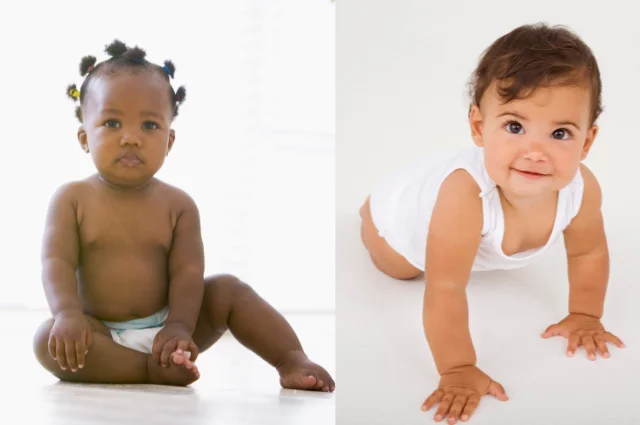Parents usually feel excited when their little one achieves a developmental milestone like sitting up and crawling. Parents often feel a sense of delight and contentment as they watch their child develop and discover the world around them since these developments signify significant growth, but when do babies sit up and crawl?
Hey! By the way… any links on this page that lead to products on Amazon are affiliate links and I earn a commission if you make a purchase. Thanks in advance – I really appreciate it! .
Babies usually start crawling between 7 and 10 months old and sit up on their own around 6 to 8 months. It’s important to understand that every baby develops differently and that some may reach these milestones earlier or later.
When do babies sit up and crawl?
Babies’ physical development varies, but most babies begin to sit up on their own between the ages of 6 and 9 months. Although some babies may begin to crawl as early as 6 months or as late as 12 months, most babies begin to crawl between the ages of 8 and 10 months.
Reasons why baby can’t sit up
A newborn may struggle to sit up for several reasons which includes
- Lack of upper body strength
- Tight muscles
- Neurological disorders
- Premature birth,
- Poor trunk control,
- Inadequate muscle tone,
- Developmental delays
The ability of a newborn to sit up can also be affected by certain health issues such as cerebral palsy, spinal muscular atrophy, and muscular dystrophy.
When to worry if a baby is not sitting up?
Although every baby develops at their rate, most start to sit up on their own between the ages of 6 and 8 months. While it may not necessarily be a cause for alarm if your baby is not sitting up by the time they are 8 months old, it is still essential to consult your pediatrician. To rule out any underlying medical concerns that might be impairing your baby’s development, you should consult your pediatrician if your baby has not begun to sit up by the time they are 9 months old. Additionally, it’s crucial to keep in mind that every baby develops at their rate
Signs baby is ready to crawl
As a parent, you might wonder when do babies sit up and crawl because seeing your baby begin to crawl is a significant developmental milestone. There are various signs that a baby is ready to begin crawling. A few of these signs include
- A baby’s ability to coordinate their arms and legs is necessary for crawling, so if your baby is beginning to reach for objects with their hands, they might be ready to start crawling
- Babies require strong head control to crawl, so if your baby can hold their heads up while on their stomach, they may be ready to start crawling.
Ensure you give your baby lots of chances to practice crawling while encouraging them to explore and play.
How to help your baby sit up
1. Do more tummy time with toys such as rattles
Do tummy time with toys much more with the baby. One of the best you can check out is the VTech baby rattle and singing puppy. To hear the vibrant beads jingle, shake the easy-to-grasp rattle. Your baby will enjoy shaking this easy-to-grasp rattle while watching the puppy’s cheeks light up and hearing the vibrant beads rattle. The music button plays catchy words, melodies, noises, and songs; it has more than 20 of them. In addition to an automated shut-off and sturdy design, it has parent-friendly features.
2. Sit them upright on your thigh
Putting your infant on your thigh while they are seated will assist them in sitting up. Babies do not yet have the physical strength to sit up on their own, hence it is important to make sure their backs are straight and that you are supporting their head and neck. To avoid any mistakes or falls, it’s also critical to always monitor them.
3. Use a Boppy cushion pillow to support the baby
With its velvety, hypoallergenic fiber content, the Boppy Pillow supports both you and your baby and has a replaceable cotton blend pillow cover. The Boppy Pillow, which was designed by a mom and supports your arms and back while raising your baby into a more comfortable posture for breastfeeding or bottle feeding. The Boppy Pillow and slipcover are machine washable.
4. Use a baby walker
A baby walker such as the Vtech sit-to-stand learning walker is an interactive learning baby walker that comes in a plain brown box and has a detachable play panel for added convenience. Kids can enjoy on the floor with the detachable activity panel while learning about animals, colors, music, shapes, and numbers. As babies get older, attach the panel to the walker so they can learn new things as they learn to sit up.
5. Use a sit-up toy and light up toys musical baby toys
The Fisher Price Deluxe Sit-Me-Up Floor Seat is really the perfect portable seat for young babies who can hold up their heads but require a little assistance sitting up because of its wide, robust base and soft fabric seat. It’s extremely fun as well as extremely comfortable. The clackers and spinners on the toy tray will keep your baby entertained for hours.
SANMERSEN Ocean Projector Light Up Toys Musical Baby Toys
The Sanmersen Ocean projector light up Toys for babies are meant for ages 6 to 18 months. Toddlers’ limitless imaginations are stimulated by the 360° rotating dolphins and turtles, along with 8 different types of lighting, which perfectly recreate the ambiance of the underwater world. It has fun music effects and lighting effects that will rapidly draw your child’s attention to the crawl and keep them entertained for a long time without becoming bored.
The age at which babies sit up and crawl varies greatly and is dependent on many factors such as their physical development, muscle strength, etc. Parents often get worried about when do babies sit up and crawl but while there are general milestones for these developments, it’s more important to focus on a baby’s progress rather than comparing them to others. Highlighted above are ways to help your little one sit up. Additionally, it is important to provide a safe environment for your little one when they start to sit up and crawl.

